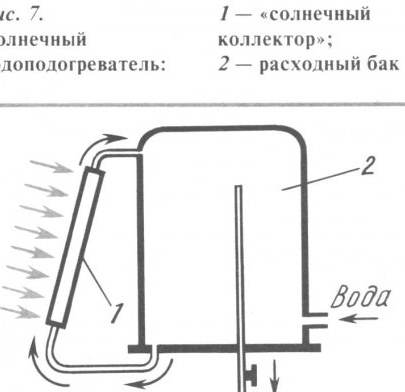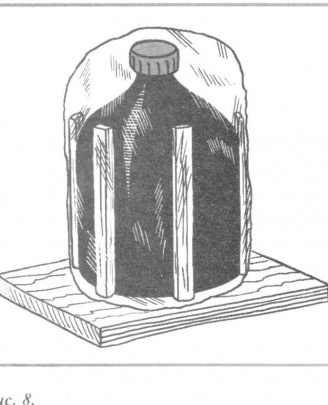1. Steady unicycle wheelbarrow.
3. Handwheel Drill.
4. We collect solar energy.
We collect solar energy.
Another "secret" of Chinese masters relates to the construction of "solar collectors" (water heaters). In fact, similar constructions in Europe (then they were called “glass boxes”, since they were made like aquariums with multi-layer glazing) have been developed since the 18th century, and one of their inventors was ... Karl Linney! The creator of the biological species classification system did not shy away from technical creativity, as did Vlez Pascal, a mathematician, physicist, and thinker.
The designs of modern “solar collectors” are usually made in the form of flat thermally insulated boxes. A blackened coil is placed at the bottom of the drawers (the latter are often used ... evaporators for refrigerators, purchased from household appliance manufacturers at relatively low prices). Single or double-layer glazing of the box is made of silicate glass, and recently - of polystyrene and other polymeric materials. A typical solar water heater is shown in figure. 7. Here, hot water in the pipes of the thermal box - the boiler rises and accumulates in the supply tank, and cold water enters the lower part of the tank.
A similar water heating system is not cheap in Europe, where fuel is relatively expensive, but pays off in 3 ... 4 years.
In our conditions summer residents and rural residents build “solar collectors” by installing a suitable metal tank in a place exposed to the sun, painting its walls black. The effectiveness of this design, of course, is incomparably lower than that of the "glass box". Can it be increased without high costs? Can! And the first thing to do is to ensure that the inclination of the larger flat surface of the tank is such that this surface absorbs solar radiation at an angle close to a straight line (the degree of inclination of the tank depends on geographic latitude). The second thing that immediately and significantly increases the efficiency of the solar water heater is its “glazing” using polyethylene, polypropylene and other films. To this end, it is necessary to attach rails to the tank (to glue or even simply pull it with wire). And already on the slats to throw a film.Keep in mind that these slats should be protected from moisture, for example, soaked with used engine oil, as condensate accumulates in the collector cavity at night, and moisture and elevated daytime temperatures provide excellent conditions for the growth of molds. Therefore, without protection, reiki in 2 ... 3 weeks can collapse!
These slats are needed to provide an air gap between the film layer and the metal surface of the tank. In this case, often installed rails increase the resistance of the structure to the action of the wind, but reduce the effective absorbing surface of the collector. Here we need a compromise that can be reached by using a grid of synthetic materials as a “reinforcement”. Using the film glazing of the collector, it is not possible, of course, to ensure the complete tightness of the “glazed" volume. But this is not particularly necessary. On the contrary, it is necessary to provide a drain to remove condensate from the collector cavity.
The European design of the "solar collector" is described above, but what did the Chinese invent? And how to use their discovery now? It turns out, based on the experience of old masters, it is easy to make a solar “micro-collector” out of improvised materials that is useful to tourists, as well as summer residents just starting to develop their plots. To do this, you just need ... a few bottles of dark glass, a few plastic films, wood trimmings and rubber bands. 2-liter pot-bellied Sangria wine bottles with screw caps are very good for such a “microcollector”. The bottle is filled with water, clogged. A few rubber spacers are attached to the bottle’s walls with rubber bands, and a plastic bag is put on top of the latter, making sure that the air gap between the surface of the glass bottle and the polyethylene is everywhere (Fig. 8). Next, the bottle is placed on a plaque (“thermal insulator”) and the edges of the plastic bag are folded under the bottom of the bottle. The design is installed in the sunniest place. Even on a not very hot day, the water in the bottle quickly heats up to 40 ... 44 ° C. You can not only pour in warm water, but also wash the dishes, wash small things.
The only inconvenience is that such warmed water is not stored for a long time, as it quickly “blooms”. Therefore, when leaving, be sure to empty the bottles.
By the way, in ancient China, “solar collectors” were made of ceramics to heat water in the sun, and instead of polyethylene, oiled paper caps were used.



